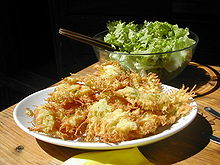Beignet
This article includes a list of references, related reading, or external links, but its sources remain unclear because it lacks inline citations. (March 2010) |
The examples and perspective in this article may not represent a worldwide view of the subject. |


A beignet (pronounced /bɛnˈjeɪ/, French for "fried dough") in the U.S. is a pastry made from deep-fried dough, much like a doughnut, and sprinkled with confectioner's sugar, or frostings. Savory versions of beignets are also popular as an appetizer, with fillings such as maple or fruit preserves.
In France, beignet is an umbrella term for a large variety of pastries made from deep-fried dough with fruit filling. The tradition of deep-frying fruits for a side dish dates to the time of Ancient Rome. Names for beignet recipes vary throughout France: beignets, bugnes, merveilles, oreillettes, beignets de carnaval, bottereaux, tourtisseaux, corvechets, ganses, nouets, vautes and others.
The term beignet can be applied to two varieties, depending on the type of pastry. The French doughnut beignet in the United States is simply a deep-fried choux pastry; this variety is very similar to Italian zeppole or the German spritzkuchen. Also, beignets can be made with yeast pastry, which might be called boules de Berlin in French, referring to Berliner doughnuts which have a spherical shape (i.e. they do not have the typical doughnut hole) filled with fruit or jam. This variety is similar to the Polish pączki and to the Portuguese Bola de Berlim.
The western parts of Germany use the term beignet for variants having a fruit filling while referring to other variants as Krapfen.
In the US, beignets are associated with the city of New Orleans where they are served at restaurants such as Café du Monde. They are also the official state doughnut of Louisiana.
In Corsica, beignets made with chestnut flour (Beignets de farine de châtaigne) are known as fritelli.
See also
References
- Yves Thuriès, French Pastry, ISBN 0-471-28598-6
- Rosana G Moreira et al., Deep Fat Frying: Fundamentals and Applications, ISBN 0-8342-1321-4
- New Orleans Style Beignet Recipe at Nola Cuisine

